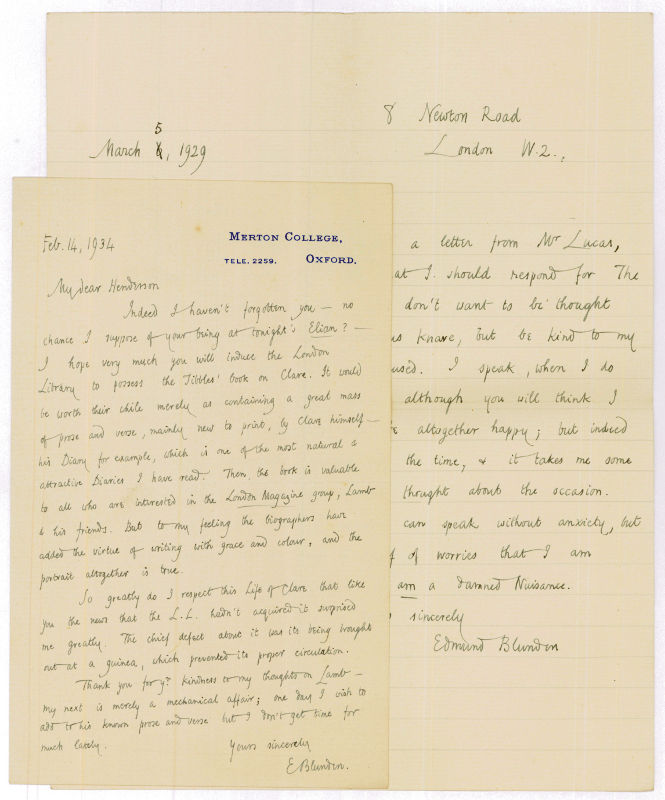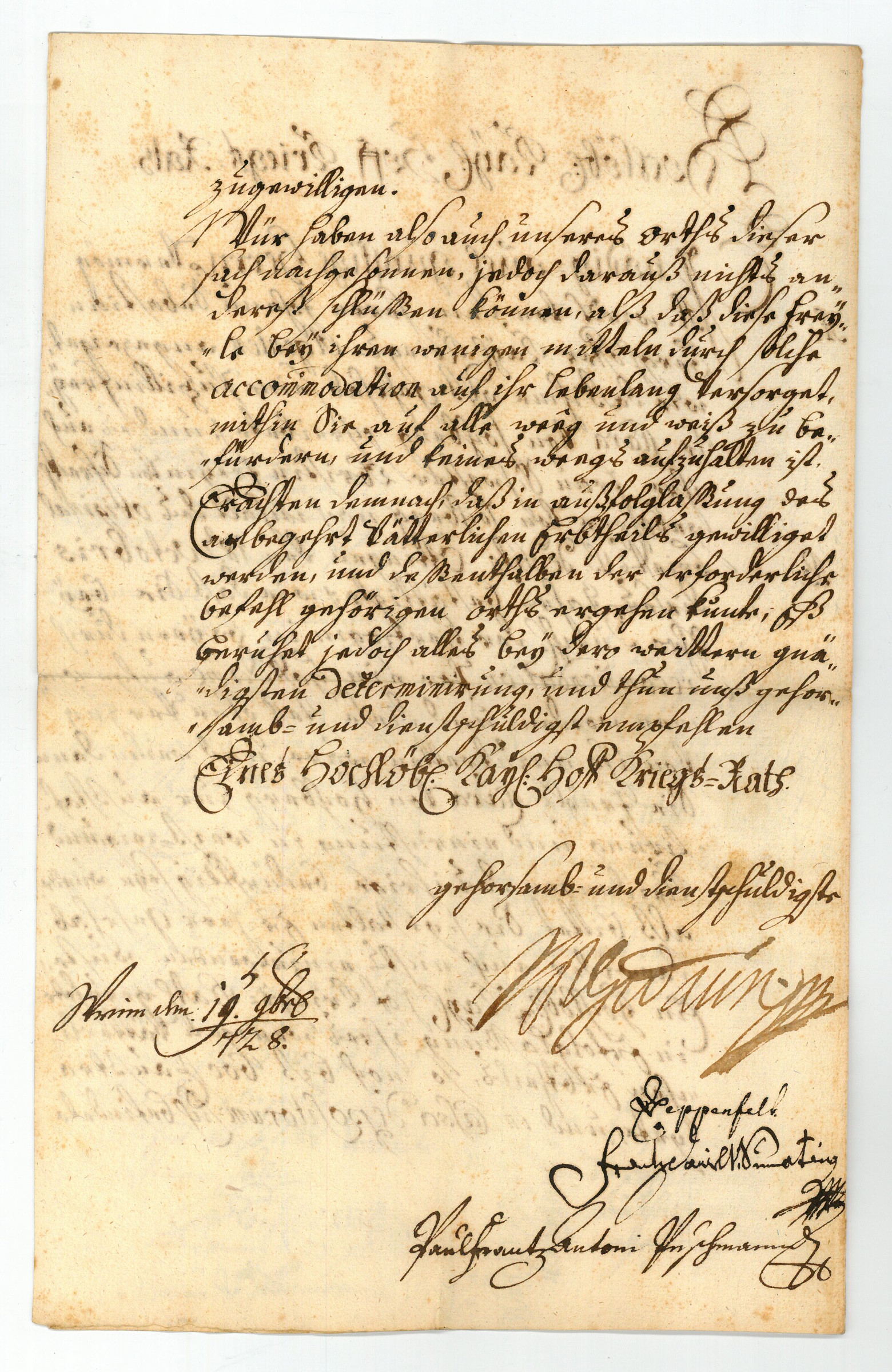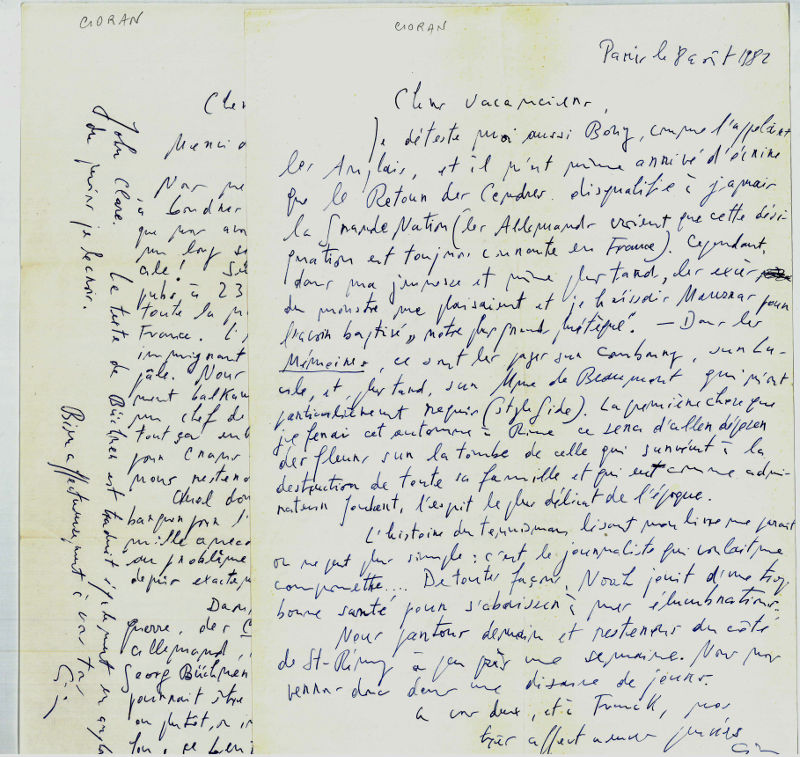
Autograph picture postcard signed.Cambridge, 28. II. 1929.
"Herrn Ludwig Forster, X, Herzgasse 18, Wien, Austria. Herzliche Grüße schickt Ihnen Ihr Ludwig Wittgenstein".
Mild toning; in pencil; the picture depicts Clare College Bridge at Cambridge.

"Herrn Ludwig Forster, X, Herzgasse 18, Wien, Austria. Herzliche Grüße schickt Ihnen Ihr Ludwig Wittgenstein".
Mild toning; in pencil; the picture depicts Clare College Bridge at Cambridge.

To John Henderson, Secretary of the National Liberal Club: "I received last night a letter from Mr. Lucas, forwarding your kind wish that I should respond for The Guests on Thursday evening. I don't want to be thought an idle vagabond or an ungracious knave, but be kind to my nervous state, + have me excused. I speak, when I do speak, under a great strain, although you will think I go on so long that I must be altogether happy; but indeed I am desperately puzzled all the time, + it takes me some days before + after of painful thought about the occasion [...]" (March 5, 1929).
"Indeed I haven't forgotten you - no chance I suppose of your being at tonight's Elian? I hope very much you will induce the London Library to possess the Tibble's book on Clare. It would be worth their while merely as containing a great mass of prose and verse, mainly new to print, by Clare himself - his diary for example, which is one of the most natural + attractive Diaries I have read [...]" (February 14, 1934).

An den kais. Kriegsrat mit einem Bericht in "Pupillar-Sachen" in der "Hochbergischen Verlassenschaftssache": "Vermög A. wirdt von dem Herrn Johann Sebastian Berghoffer Kayl. Kriegs-Agenten angezeiget, wie daß ihme alß Gehrhab seine Pupillin Freyle Clara von Hochberg schreibete (und es auch ihre Frau Schwester Obristin Freyin von Schweckg gebohrne von Hochberg nach inhalt des original Briefs B. de dato Öttingen den 18. ten Octobris dieses Jahrs bestättigte) wie daß Sie bey Ihro Durchl. der Hertzogin in Bayern durch recommendation vor ein Hoffdame aufgenommen worden, und diese stell ohne Verzug von ihr anzutretten wäre, und weilen dann Sie Freyle Clare von Hochberg zur außstaffirung und einrichtung in weiß-zeig, und Kleidungen das ihrige bedürftig seyn würde, alß bittet Sie (gestalten Er Herr Gehrhab darwider auch nichts einzuwenden wüßte). Ein hochlöbl. Kay. Hof Kriegs-Rath geruhete in Erfolglaßung ihres wenigen Vätterlichen Erbtheils, so noch biß 600 [...] außtragete, und in Cassa depositorum sich befindete zugewilligen [...]".
Mit Regestierung und Gegenzeichnung verso.

To Jean Lessay, concerning, among other matters, a translation of Georg Büchner's "Lenz" (1973): "Merci de votre carte galloise. Nous ne sommes restés que quelques jours à Londres mais ils furent si pleins que nous avons l'impression d'y avoir fait un long séjour l'inoubliable Brown ale ! Seule tache : la fermeture des pubs à 23 h. Si on les laissait ouverts toute la nuit, je ne serais pas rentré en France. L'Angleterre aurait pu assimiler un immigrant de plus, un " Asian " quelque peu pâle. Nous avons assisté à une scène suprêmement balkanique dont l'acteur principal était un chef de gare hindou. On vous racontera tout ça en septembre. Nous partons demain pour Crams-su-Sierre (Poste Restante) où nous resterons une dizaine de jours. Quel dommage que vous n'ayez pas vous embarquer pour l'Islande ! Vous en auriez emporté mille anecdotes et-qui sait ? -quelques solutions au problème le plus tragique et le plus gratuit depuis exactement dix siècles. Dans le numéro spécial publié avant la guerre, des Cahiers du Sud, sur le romantisme allemand, il existe un texte : Lenz de Georg Büchner (traduite par Albert Béguin) qui pourrait être utile à Franck. On y décrit ou plutôt, on imagine la déchéance d'un poète fou, ce Lenz qui ressemble par certains côtés à John Clare. Le texte de Büchner est traduit également en anglais, du moins je le crois. Bien affectueusement à vous tous".

A fine monastic prayerbook manuscript, with readings for the various canonical hours as well as other feasts and Sundays of the ecclesiastical year, ending on fol. 59v with the scribal colophon. The prayers are followed by the Penitential Psalms (fol. 61r) and a Litany of Saints (fol. 69v) in which 'Johannes' is singled out in red and blue ink. The Office of the Dead (fol. 76v) follows; the 'Psalter of the Lord's Passion' (fol. 109r) completes the volume.
The manuscript was written by a female scribe who names herself "Soror Anna Schöttin" at the foot of the text on fol. 59v; she locates and dates the volume to "Norimbergiae Anno 1487" at the foot of its last leaf. There were only two houses for women in medieval Nuremberg: the Poor Clares and the Dominican convent dedicated to St. Catherine of Alexandria. While the absence of St Clare from the litany makes the former possibility unlikely, both SS. Catherine of Alexandria and the Dominican Catherine of Siena appear here. The Nuremberg Katharinenkloster was founded in 1296 and grew into a major cultural hub of the region; through gifts and its own productive scriptorium, its library was one of the largest in Germany by the end of the 15th century. The monastery declined rapidly after the city became Lutheran in 1521, and its last member died at the close of the 16th century. A half-page space left by the original scribe on the last leaf is filled with near-contemporary religious exortations which probably show the continuing use of the book at the convent, but the 17th century additions (similar material on fols. 49r, 60r, an endleaf and replacing a line or two of text on fol. 13r) perhaps indicate that the volume was carried removed from Nuremberg in the 16th century and continued in use elsewhere.
By the early 18th century the prayerbook appears to have entered private hands, as shown by the inscribed ownership of A. Büttner (dated Halle, 1708) on the first flyleaf. In the middle of the 19th century it was in the joint collection of Andrew G. Hammond (ca. 1811-67) and his wife Mary S. Hammond, née Ripley (ca. 1820-82), of Hartford, Connecticut (their oval inkstamp on verso of front endleaf, noting this book as their MS 2). Their library is known also to have contained a 12th century English Seneca fragment (Takamiya MS. 85, now in the Beinecke Library in Yale) and a collection of John Skelton's poems in manuscript (later Phillipps' MS. 10112, now Folger Library, Nb49). A. G. Hammond served as cashier and later President of the National Exchange Bank of Hartford; he was also a member of the Connecticut Historical Society. Their son, named after the father, was a neighbour and friend of the Clemens family at Hartford. A. G. Hammond jr. enjoyed a distinguished army career and may have liaised Mark Twain's long and close relationship with the U.S. Military Academy at West Point.